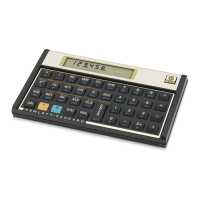74
Forecasting
Simple Moving Average
Moving averages are often useful in recording of forecasting sales figures, expenses or
manufacturing volume. There are many different types of moving average calculations.
An often used, straightforward method of calculation is presented here.
In a moving average a specified number of data points are averaged. When there is a new
piece of input data, the oldest piece of data is discarded to make room for the latest input.
This replacement scheme makes the moving average a valuable tool in following trends.
The fewer the number of data points, the more trend sensitive the average becomes. With
a large number of data points, the average behaves more like a regular average,
responding slowly to new input data.
A simple moving average may be calculated with your HP 12C Platinum as follows.
1.
Press fCLEARH.
2. Key in the first m data points (where m is the number of data points in the average)
and press _ after each entry.
3.
Press gÖ to obtain the first average.
4.
Key in the oldest (first value) entered in step 2 and press g^.
5.
Key in the newest data point (m + 1) and press _.
6.
Press gÖ to obtain the next value of the moving average.
7. Repeat steps 4 through 5 for the remaining data.
Example 1: An electronics sales firm wished to calculate a 3-month moving average for
the dollar volume of components sold each month. Sales for the first six months of this
year were:
January $211,570 April 131,760
February 112,550 May 300,500
March 190,060 June 271,120
12c platinum / 12C
RPN Keystrokes
12c platinum
ALG Keystrokes
Display Comments
fCLEARH fCLEARH
0.00
211570_ 211570_
1.00
112550_ 112550_
2.00
190060_ 190060_
3.00
gÖ gÖ
171,393.33
3-month average for March.

